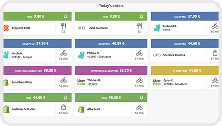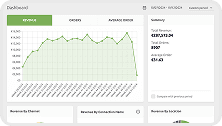HubRise User Guide
Data
The Data section provides records for orders, customers, catalogs, and inventory. At any time, you can select which Account and Locations to display.
Orders
The ORDERS page displays your recent orders, with the most recent on top. For every order on the list, you can find the following attributes:
- DATE (UTC+02:00): The date, time, and unique identifier for the order.
- LOCATION: If you select All locations, this column shows the Location that received the order.
- CUSTOMER: The customer that made the order.
- AMOUNT: The total amount of the order.
- STATUS: The current status of the order. For an overview of possible statuses, see the Order status section of the HubRise API Order Management page.
- ORIGIN: What app the order was generated from.
To filter orders by start and end date:
- Select From and To fields in and set the date ranges to filter by.
- Select the search icon
 to filter records by these dates.
to filter records by these dates. - To clear the date filters, remove the dates from the From and To fields, then select the search icon
 .
.
Click on the date of the order to view full details. To view the full details of the request, click the date and time in the Logs section. For more information, see Logs.
Related FAQ: How Do I Check If the Connection Between My System and HubRise Is Working?
Customers
The CUSTOMERS page displays the selected customer lists for the selected Account. Customers are ordered by reverse creation date.
The records on this page display the following attributes:
- NAME: The customer's name followed by their unique identifier.
- ORDERS: How many orders the customer made since registration.
- SPENDING: How much the customer has spent across all orders made on the Account.
- SINCE: The date of the customer's first order.
To filter customers by name or email address:
- If there are multiple customer lists for the Account or Location, select the drop down list next to Customers and select the customer list to display.
- Click the Search by name or email field and enter the text to search for.
- Select the search icon to filter the customer records.
- To clear the customer filer, remove all text from the Search by name or email field then select the search icon
 .
.
To see full details of a customer, click the customer name. To see the full logs of all the requests that make changes to the customer list, click View logs.
To create, edit or remove a customer lists, see Customer Lists.
Catalogs
From the CATALOGS page, you can view the catalogs pushed into HubRise and the logs of the requests that made changes to the catalog.
Connected apps that have access to your HubRise catalog can pull its product list or push new products into it. For example, a connected EPOS can push its catalog into HubRise for an e-commerce website to use it. If required, you can also edit the catalog using Catalog Manager, a free app available on HubRise. For more information, see Catalog Manager.
View Catalog
Accounts and Locations can contain multiple Catalogs. To view a specific Catalog, select it from the dropdown list next to the title Catalogs.
Catalogs are presented in three tabs:
- SKUS: The items that you sell to the customers.
- DEALS: The deals available in the catalog. A deal offers a price reduction on products purchased together. Examples include a three-course meal (starter, main course, and dessert) and Buy One Get One Free offers.
- DISCOUNTS: The discounts available in the catalog. Discounts apply savings to the overall order rather than specific products. For example, FREEDELIVERY might remove the delivery fee for the entire order, or FRIDAY might provide a 10% discount to the entire order on Friday.

For SKUs, you can see the following attributes:
- CATEGORY: The category for the product, for example Boots.
- PRODUCT: The name displayed to the customer. Product names do not need to be unique. For example, you may sell shoes of different sizes, but with the same product name Waterproof boots.
- SKU: The SKU or product size. For example, in the case of Waterproof boots, you might sell a SKU with size 28 and black colour, and another SKU with size 32 and brown colour.
- PRICE: The price of the product, and the currency used.
- REF CODE: The unique identifier of the product from the source product management system. This identifies the item across all apps. Identifiers are alphanumeric with special characters. For example,
boots_waterproof_size_28_blackcan refer to a pair of boots with size 28 and black colour.
For Deals and Discounts, you can see the following attributes:
- NAME: The Deal or Discount name.
- REF CODE: The unique identifier of the Deal or Discount from the source product management system.
To see the full logs of all the requests that make changes to the catalog, click View logs. For more information, see Logs.
To create, edit or remove a catalogs, see Catalogs.
Inventory
The INVENTORY page displays the inventory entries for the selected Location. You must select a Location to view its inventory. If no Location is selected, a message prompts you to select one.
Inventory entries are presented with SKU entries first, sorted by their ref code, followed by Option entries, also sorted by their ref code. In the absence of an inventory entry for a SKU or Option, the quantity is considered unlimited.
The following attributes are displayed for each inventory entry:
- SKU / OPTION: The type of inventory entry, either SKU or Option.
- REF: The ref code of the SKU or Option.
- STOCK: The current stock level. If the stock level is
0, the item is out of stock.
To see the full logs of all the requests that make changes to the inventory, click View logs. For more information, see Logs.
Logs
Each page in the DATA section provides more information through its log page.
Logs record the requests from an app to HubRise. Each request is a transaction between an app and HubRise, such as an order, a new customer registered, or a catalog update.
The log page displays a summary list of requests in reverse chronological order. When you open an order in the ORDERS page, select a log on the CUSTOMERS page or click on View logs on the CATALOGS page, the following information is displayed:
- TIME (UTC+02:00): The date and time of the request, in UTC format.
- ORIGIN: The app that created the request.
- RESOURCE: The target of the request.
- METHOD: The HTTP method used in communicating the request.
- URL: The URL path for the request.
- RESPONSE: The HTTP response code.
Further log details are available for advanced users and developers to view app communications and troubleshoot issues. To view details for a log entry:
- Click the row to display. A full list of the query and response will be displayed.
- To download either the query or response, select the download icon
 . The selected query or response will be provided as a JSON file.
. The selected query or response will be provided as a JSON file.
The logs can be filtered based on specific criteria, including resource, method, and time range. To filter logs:
- Click the Filter section located at the top of the page. Upon clicking, you will see the filter options.
- Apply one or more filters. The log entries will refresh automatically.
- To revert to viewing all logs, click Reset.
For more information, see Understanding Logs in HubRise. For a complete reference on the HubRise API, see the HubRise API Reference page.


